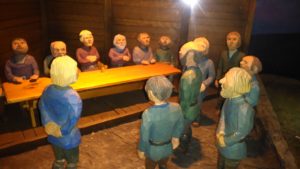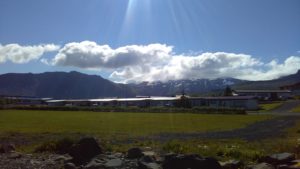Last weekend I rented a car and explored the Snæfellsnes Peninsula, to the northwest of Reykjavík. You may remember from my first post that Snæfellsjökull (“Snow-mountain-glacier”) features as the point of entry deep into the earth in Jules Verne’s Journey to the Center of the Earth. Here’s a photographic summary of my trip! I didn’t journey to the center of the earth or anything, but I definitely saw some magnificent natural wonders!
Not far out of Reykjavík, on my way to Borgarnes, I came across this beautiful stream which apparently is also a great fishing spot. Don’t try fishing here without a permit, though! This stream is on private land.  Borgarnes can boast of the outstanding Settlement Center Museum, which houses wood sculptures of the great Icelandic saga Egils saga Skallagrímssonar. As a medievalist, it was so exciting to see the medieval stories brought alive through art!
Borgarnes can boast of the outstanding Settlement Center Museum, which houses wood sculptures of the great Icelandic saga Egils saga Skallagrímssonar. As a medievalist, it was so exciting to see the medieval stories brought alive through art!

Below are some lava fields on the way to Grundarfjörður, a town where I stayed the night.

Here I am climbing Kirkjufellsfoss (“Waterfall of Church Mountain”), which overlooks Grundarfjörður.


One of my favorite aspects of driving around Iceland is seeing Icelandic horses almost everywhere I go! Though they are smaller than many breeds of horses, whatever you do, don’t call them ponies. These horses were brought to Iceland by the Norse settlers who came beginning in the late 9th century, and Icelanders are very proud of them. These horses are conveniently near a picturesque ruin, making for a great pic!

Pictured below is one of the many lava fields of Snæfellsjökull National Park. In the back of the picture you can see two enormous cliff-like rock formations jutting out of the shore into the water.

Here’s Snæfellsjökull itself (below)! One of my favorite medieval Icelandic stories is Bárðar saga Snæfellsáss (Saga of Bard the Snow-Mountain god), and yes, he is supposed to have lived here. There’s a statue of him in Arnarstapi which was made in the 20th century by the sculptor Ragnar Kjartansson. You can read the story in English in Icelandic Histories and Romances, translated by Ralph O’Connor (Stroud: Tempus, 2002).

The Cliffs of Arnarstapi (below) are astonishing beautiful, and the area echoes with the cries of the many seagulls which make their home here.  Restaurants in Arnarstapi are known for their incredible fish & chips, and their reputation is not understated! This was probably the best fish & chips I’ve ever had.
Restaurants in Arnarstapi are known for their incredible fish & chips, and their reputation is not understated! This was probably the best fish & chips I’ve ever had.

As I’m writing this I’m sitting in a café in Reykjavík sipping a latte which I ordered in Icelandic! I’m proud that I managed to have a conversation with the barista in Icelandic and pretty much understood all of what she said (not to mention, she could understand me). Icelandic is definitely difficult to pronounce and speak, but I’m making some great progress while here.
Stay tuned! Next post I will talk about Iceland’s medieval heritage and its continuing role in Modern Icelandic culture!